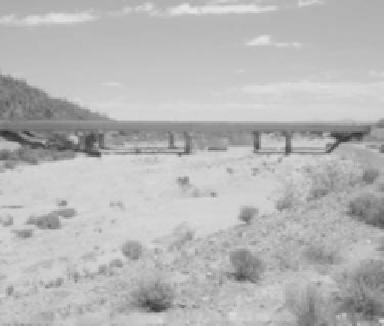Environmental Engineering Reference
In-Depth Information
FIGURE 9.7
Santa Cruz River, south of Tucson, Pima Co., Arizona (June 2009), showing channelization with the absence
of typical riparian vegetation because of lowered water table and ground water pumping (also see Chapter 5).
the San Pedro River in southern Arizona had a profound effect on birds. Abundance of
birds doubled over a 4 year period after grazing was eliminated and detection of 26 bird
species increased.
36
Although cattle may reduce fuel loads in some biomes, such effects
typically do not occur in relatively arid communities.*
Many rivers in the southwest were historically dominated by Fremont cottonwood and
willow (
Salix
spp.), but anthropogenic effects typically associated with the cattle industry
have changed natural vegetation. When water diversion and ground water pumping cause
depletion of alluvial aquifers and the decline of regional groundwaters, perennial stretches
of rivers can become ephemeral. This “desertification” along rivers also alters herbaceous
vegetation and allows establishment of exotic invasive species such as saltcedar (
Tam arix
ramossisima
).
3 7, 3 8
In some rivers, shallow water tables have declined 200 m and caused total
loss of riparian vegetation (Figure 9.7).
39,40
The increase in frequent winter flooding, high
rates of stream flow during spring, and removal of livestock allowed some self-repair and
reestablishment of native vegetation that benefits wildlife.
37
One consequence of grazing practices in arid landscapes, especially widespread in the
arid Southwest, is increased availability of artificial water sources
41
; ranchers must provide
access to water throughout their grazing allotments given the daily requirements of free-
ranging cattle by construction of “cattle tanks.”
30
In addition, small water developments
(guzzlers), created for wildlife beginning in the 1940s, now supply water for wildlife and
livestock.
42
Ranchers and those supporting their continuation on public lands have recently
recast this activity as environmentally benign, even beneficial to native wildlife.
32
Indeed,
water quality in artificial water sources appears to be good with low levels or no evidence
of blue-green algal toxins or
Trichomonas
.
42,43
Some wildlife, such as birds (dove, quail)
and mammals (deer, rabbits) may benefit from artificial water sources if they are water
limited under natural conditions.
44,45
Many of these wildlife are subjected to recreational
hunting, and thus this practice is viewed positively by those individuals and in part by
state wildlife agencies supported by hunting license fees.
In spite of these examples, artificial water sources represent a dramatic departure from
the historic condition for the arid communities of the Southwest and do not benefit all
*
See citations in Sullivan.
32


Search WWH ::

Custom Search